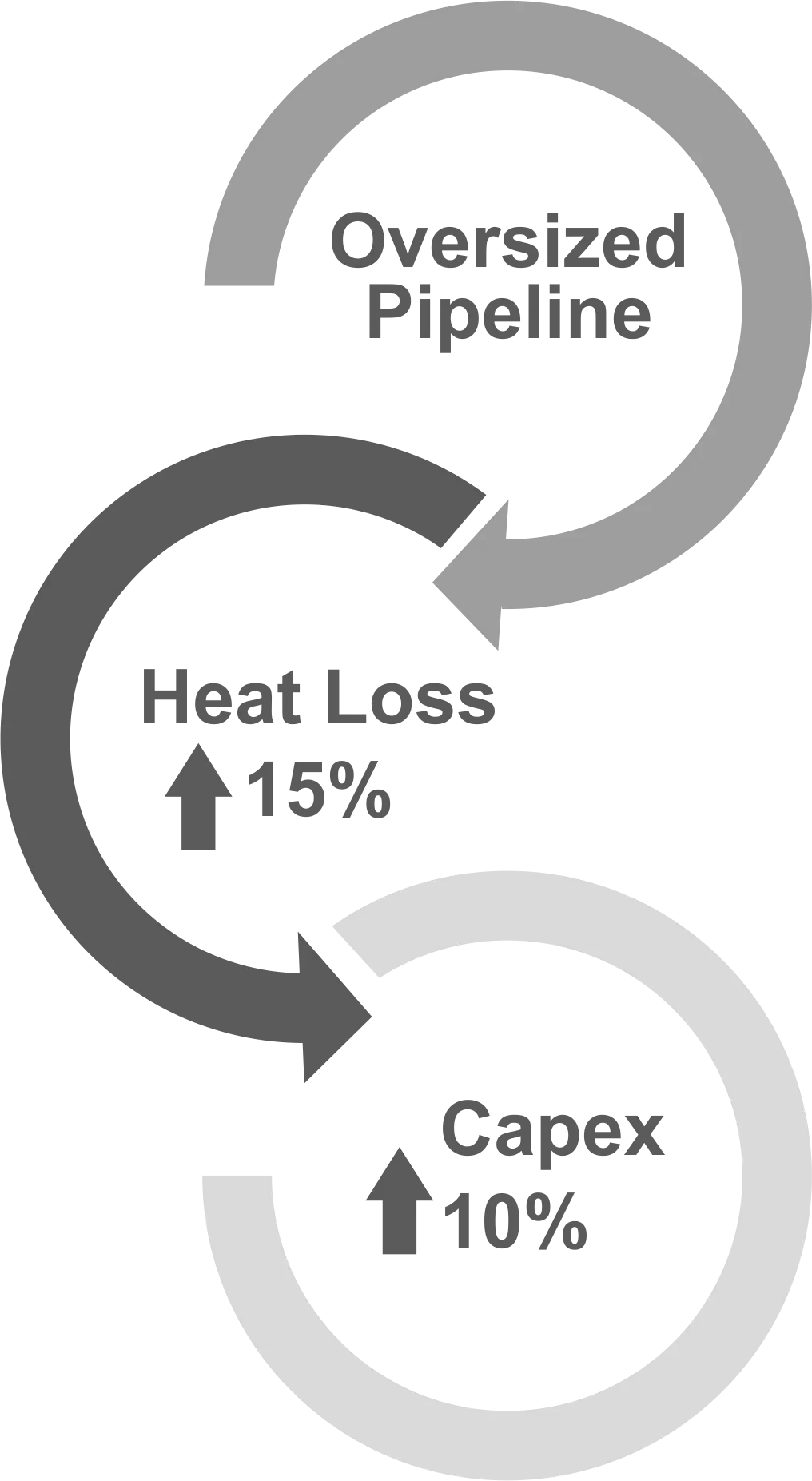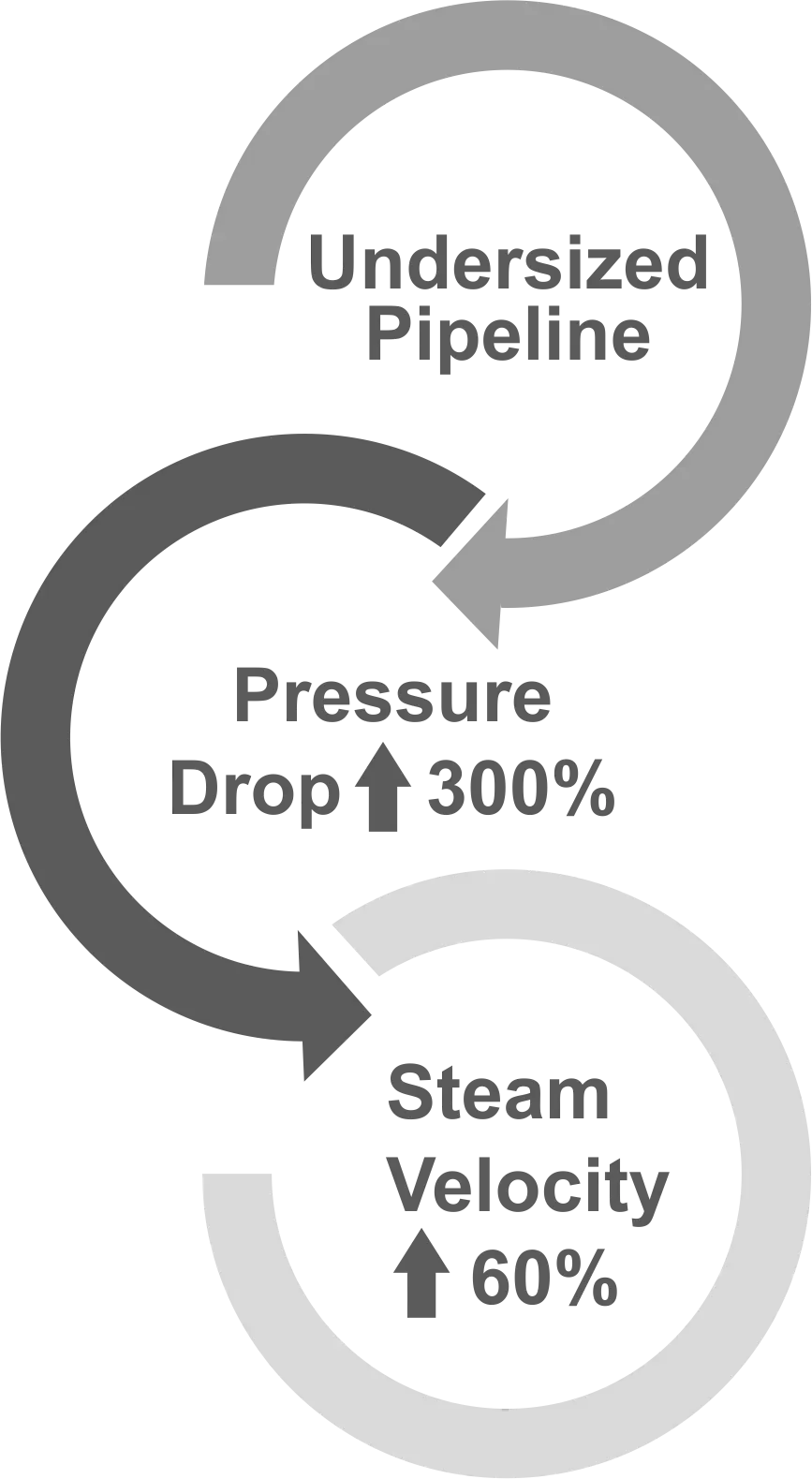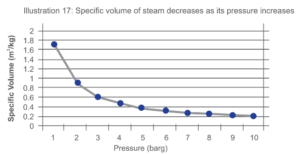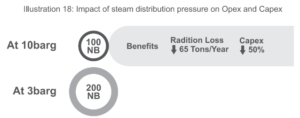How to ensure the right quantity of steam is supplied to the process
Processes are dynamic and heat load requirements vary significantly, due to various factors including start up loads, product mix, seasonal demand and plant load factor. It is essential to ensure that the right quantity of steam is provided to cater to the heat load requirement of the process.
Plants often face severe issues of pressure drop / non availability of desired steam flow rate. This occurs when pipe sizing calculations are not done right. For a given application, there is only one technically right pipe size and both undersized and oversized pipelines have adverse effects.
Illustration: Impact of oversizing or under sizing steam pipelines

When pipelines are oversized, heat losses due to radiation and convection are higher and the cost for piping, supports and insulation are also higher.
Example:
Required 80NB but installed 100NB

When pipelines are undersized, the pressure drop is higher and the desired pressure / flow will not be available at the process equipment, impacting process batch time and product quality. The steam velocity is also higher increasing incidences of water hammer.
Example: Required 100NB but installed 80NB
3.1 Always distribute steam at high pressure
Before sizing steam pipelines, bear in mind that it is advisable to always distribute steam at / dose to boiler rated pressure. Distributing steam at high pressure has the following advantages :
- The specific volume of steam decreases as its pressure increases.
Therefore at higher pressure you will require smaller pipelines to distribute steam.

Smaller bore pipelines, reduces the cost of piping, associated piping accessories, insulation (lagging) and support structure. Smaller pipelines have less surface area, therefore the radiation losses are also lower. Thus, both Capex and Opex are lower.
Illustration
A plant requires about 3.8 tons/hour of steam in the process. The conventional approach of reducing steam pressure to 3barg within the boiler house and then distributing steam to the process would require a 200NB line to carry the required steam flow rate. However, if steam is distributed at boiler generation pressure (in this case at 10barg), a 100NB pipeline would suffice.

3.2 Reduction In steam pressure results In an Improvement In dryness fraction
Distributing steam at high pressure and subsequently reducing its pressure at the point of usage offers another advantage. High-pressure steam contains a significant amount of heat energy, but when its pressure is reduced using a Pressure Reducing Valve (PRV), it can no longer retain that heat content. As a result, the excess heat is utilized to dry the steam. The resulting improvement in its dryness fraction, means that more useable heat is available for the process, thereby reducing steam consumption.

This is how steam dries up at the PRV outlet. Drier steam has more latent heat to offer to the process, resulting in reduced steam consumption.
3.2 Steam Pipeline Sizing
3.4. Provide headers within the steam distribution system
A steam distribution header is a manifold where steam from a single / battery of boilers is collected and distributed to different utilisation sections, blocks or equipment. The objectives of a steam header are:
- To facilitate isolation of the boiler or a section or equipment from a single location
- Act as a buffer to cope with fluctuations in steam demand as the size of the header is greater than the size of the steam lines
- Enable modularity in the design for future expansions; spare nozzles can be provided to allow addition of new boilers, sections or equipment
- To provide space to facilitate effective separation of air and condensate from steam
The following accessories should be installed on the header:
- Air vent
- Drain trap
- Pressure and temperature gauge
- Safety valve
Provide pressure and temperature gauges within the steam distribution system
The availability of pressure and temperature gauges within the steam distribution system can make a significant difference in enabling plant personnel to sustain steam system performance. They serve the following purposes.
Safety:
Pressure and temperature gauges allow plant personnel to monitor and control the steam pressure / temperatures. Timely corrective actions can be taken to avoid / eliminate an over-pressurised system or overheating, thereby preventing accidents.
Uptime:
Pressure and temperature are important parameters in the steam system that can trigger maintenance actions. For example, in case of control valves, changes in pressure / temperature can denote possible malfunction.
Efficiency:
Using steam at the lowest possible pressure for indirect heating reduces the quantum of steam required. This is because latent heat increases with decrease in steam pressure. Pressure gauges in the system can enable plant personnel to ensure precise steam supply pressure to the process.
Troubleshooting:
Pressure/temperature gauges at strategic locations in the steam system can also facilitate troubleshooting. For example in case of pressure drop issues, it can help pinpoint the location and make it easier to arrive at the cause of the problem. A combination of pressure and temperature gauges can also help to detect the presence of air in the system.
Pressure gauges should be installed
- On steam headers
- Upstream and downstream of pressure reducing valves
- On pressure vessels like boilers, flash vessels, etc.
Temperature gauges should be installed
- On process equipment
- At the inlet and outlet of heat exchangers
- Along with pressure gauges within the distribution network to determine the presence of air and non-condensable gases.
Install steam flow meters at strategic locations within the network
The first step for any plant which wishes to reduce opex by promoting efficient use of steam is to be able to accurately monitor its consumption. The presence of steam flow meters can enable the following.
Costing: Quantify the steam consumed per unit of product (specific steam consumption) enabling accurate cost allocation to products/ production
Benchmarking: The best an average specific steam consumption analysis of the plant/equipment and comparison against similar plants/equipment can help establish the potential for improvement
Troubleshooting: Deviations in steam consumption or a gap between steam generation and consumption can help identify losses in the plant
Maintenance: Deviations in steam consumption can trigger the need for maintenance in the system
While different types of flow meters are used across plants to measure steam consumption, vortex flow meters offer the highest accuracy.
